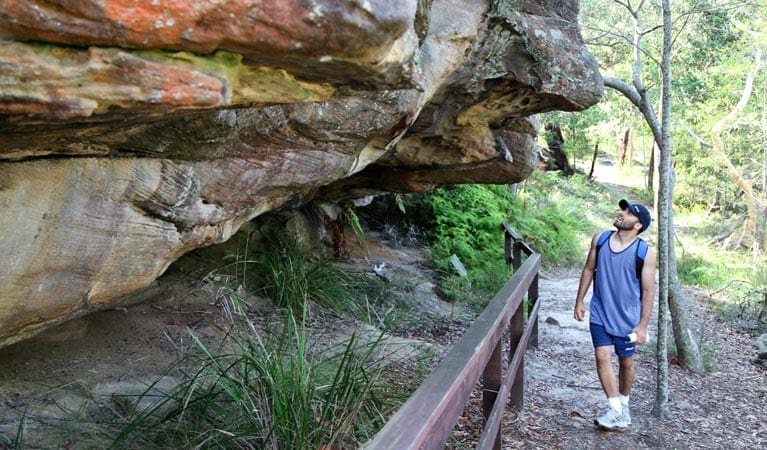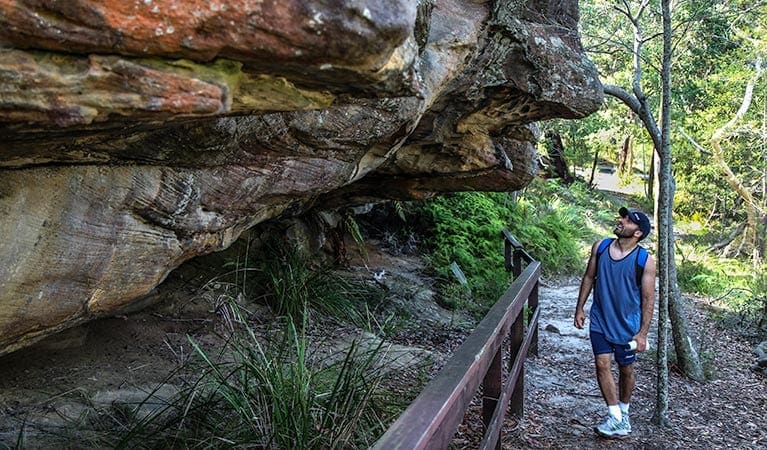Hike at a Glance
Max elevation: 0m
Min elevation: 0m
Total Ascent: 0m
Hike overview
This track winds down West Head's eastern face in Ku-ring-gai Chase National Park. Some parts are so steep you'll be scaling ladders.
Much of the original wartime track work still exists, uncovered by NPWS and West Head Awareness Team volunteers during track upgrades. But the real reward for history buffs is the destination. Perched above the shoreline, the army battery once hosted two 4.7-inch ex-naval guns supported on 800kg pedestals, an observation post, ammunition storage and 2 searchlights.
Today, the silent structures are a fascinating reminder of the days when heavy equipment was transported down the track via a purpose-built railway. Take a moment to wonder at the strength of the soldiers who built the steps and carried materials down to the site.
Head back the same way to West Head lookout, through casuarina forest that's a favourite of glossy black cockatoos.
To find out more about the history of West Head Battery visit 4HResearch.
Gallery
Got some great shots from this hike? Upload your photos here to inspire others and show off the beauty of the trail!
Click to view form >>
Submitting your photos doesn’t mean you lose ownership. You can be credited for your contributions, and you can request removal at any time.
Content use
Please don’t copy GPX files or content from this site to AllTrails or other platforms. Each trail has been personally mapped, documented, and refined to support Australia’s bushwalking and hiking community. While some details come from land managers, every listing reflects significant personal effort. This is a free, community-driven initiative—your respect helps keep it that way.
Walk map and GPX file
It looks like I don’t have a GPX file for this trail yet. If you have one to share, please email it to me! I’ll verify it against official maps before adding it to help other hikers have a safer, easier experience. Thanks for contributing to a better hiking resource.
Getting there
Getting to the trailhead: Ku-ring-gai Chase National Park.
West Head Army Track starts at West Head lookout, in the West Head precinct of Ku-ring-gai Chase National Park.To get there follow West Head Road or access the lookout from the Resolute picnic area, along the West Head lookout track (1.9km). Road quality Sealed roads Vehicle access 2WD vehicles Weather restrictions All weather Parking Parking is available at the West Head lookout carpark (around 20 spaces). It’s a 50m walk from the carpark down to the lookout.
Visit NSW National Parks and Wildlife Service for more information on this trail.
The longitude and latitude of the start and end points are approximately only and should not be used for navigation purposes. Please contact me if you know the correct coordinates.
Closest towns to this walk: Akuna Bay, Bayview, Berowra, Berowra Heights, Bobbin Head, Church Point, Davidson, Elanora Heights, Frenchs Forest, Gordon, Hornsby, Ingleside, Manly, Mona Vale, Mosman, Mount Colah, Newport, North Narrabeen, North Sydney, North Turramurra, Pittwater, Pymble, St Ives, Terrey Hills, Wahroonga, Warrimoo, Warringah
About the region
Located in Sydney's north, Ku-ring-gai Chase National Park combines important history with scenic beauty, making it perfect for school excursions. Bobbin Head is a great place for a family picnic, and parts of the park are ideal for cycling, fishing and bushwalking.
Australia's second-oldest national park, Ku-ring-gai Chase National Park is a recreational favourite for locals and visitors alike. This large park, in Sydney's north, lets you feel at one with nature without leaving the Sydney metropolitan area. A heritage-listed park, it combines important history with scenic beauty.
Winding creeks and stretches of ocean meet rainforest and eucalypts, rocky cliffs and mangroves. Camp at The Basin or spend your time exploring walking tracks, mountain biking trails, breathtaking lookouts and significant Aboriginal sites. You'll still have plenty of time to discover its marinas, cafes, kiosks and well-equipped picnic areas."
Similar walks nearby
Looking for more walks in or near Ku-ring-gai Chase National Park? Try these trails with a similar difficulty grade.
Track grade
Grade 4 (Hard) - Challenging Walks for Experienced Walkers: Grade 4 on the AWTGS signifies challenging walking tracks. Bushwalking experience is recommended for these tracks, which may be long, rough, and very steep. Directional signage may be limited, requiring a good sense of navigation. These walks are suited for experienced walkers who are comfortable with steeper inclines, rougher terrain, and potentially longer distances.
Explore safe
Plan ahead and hike safely! Carry enough water, pack layers for changing conditions, and bring safety gear like a torch, PLB, and reliable communication device. Check official sources for trail updates, closures, and access requirements, and review local weather and bushfire advice. Most importantly, share your plans with someone before you go. Being prepared makes for a safer and more enjoyable hike! Stay Safe, Explore More, and Always #ExploreSafe.
Packing checklists
What you carry in your pack depends on factors like weather, terrain, and your adventure type. Not sure what to bring? My free planning, food, and packing checklists are a great starting point, covering day hikes, overnight trips, and multi-day adventures. Use them to customise your kit and always prioritise safety.
Let someone know
Before heading out, take a moment to fill out your trip intentions form. It’s a quick way to share your hike details with family or friends. If something goes wrong, they can notify emergency services, ensuring a faster response and peace of mind. Stay safe and enjoy your adventure
Suggest an edit
Spotted a change on this trail? Maybe there are new features, the route has shifted, or the trail is permanently closed. Whatever the update, I’d love your input. Your feedback helps fellow hikers stay informed and ensures that our trail info stays fresh and reliable.
Acknowledgement of Country
Trail Hiking Australia acknowledges the Traditional Owners of the lands on which we hike and pay respects to their Elders, past and present, and we acknowledge the First Nations people of other communities who may be here today.






